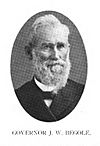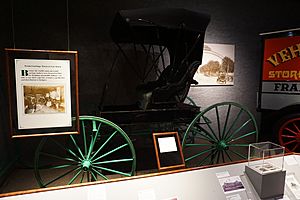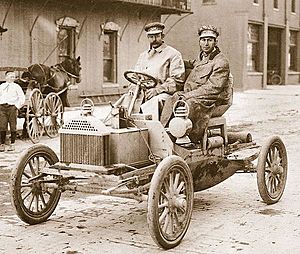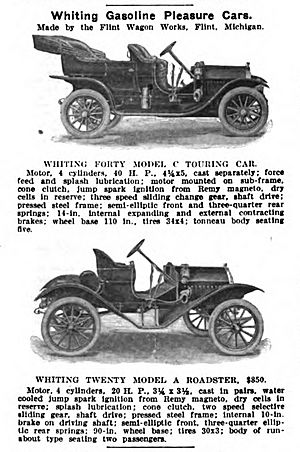Flint Wagon Works facts for kids
The Flint Wagon Works was a big company in Flint, Michigan. It started making wagons in the early 1880s. This company was one of the most successful makers of horse-drawn vehicles in the world. Along with other companies in Flint, it helped create the American car industry. By 1905, Flint was even called Flint the Vehicle City. Today, the area where the factory used to be is known as "Carriagetown."
Flint Wagon Works helped bring the car industry to Flint. They did this by buying David Buick's business from Detroit and moving it to Flint.
Later, Flint Wagon Works had many financial problems. Its owners sold the business to William C. Durant in 1911. Durant used parts of the company to start making Little cars. But these cars were not very good and their name was not popular. So, Durant combined the Little company with Chevrolet in 1913. After that, the factory became part of what was later known as Buick City.
Contents
How Flint Wagon Works Started
| Flint Wagon Works began because James H. Whiting had an idea. He was a manager at a lumber company called Begole Fox & Co. Whiting suggested that Begole Fox should start making wagons.
The first people to partner in this new business were James H. Whiting, Josiah W. Begole (who later became the governor of Michigan), David S. Fox, George L. Walker, and Allen Beach Sr. Allen Beach Sr. was the superintendent, but he passed away in 1885. They named their new company Flint Wagon Works. In the early 1880s, they built a factory on West Kearsley Street in Flint. It was on an empty lumber yard owned by Begole Fox. Later, William S. Ballenger Sr., Charles A. Cumings, and Josiah Begole's son, Charles Myron Begole, joined the partnership. Josiah Begole died in 1896. Begole Fox had started their lumber business in 1865. They were one of the biggest lumber dealers in Flint. They also made many shingles and lath (thin strips of wood). |
Flint's Top Wagon Makers
Flint Wagon Works became the second of Flint's "Big Three" wagon builders. The first was started by William A. Paterson in 1869. The third major company was William C. Durant's Flint Road Cart Company. This company later became the Durant-Dort Carriage Company.
Their main competitor was the Studebaker Brothers Manufacturing Company from Indiana. In 1904, here's what was reported about the top wagon makers:
- Flint Wagon Works made mostly wagons (75%) and farm wagons (25%).
- William A. Paterson could make 30,000 vehicles each year. They made 75% carriages and 25% spring wagons.
- Durant-Dort Carriage Company could make 70,000 vehicles each year.
Making Automobiles
Buick Cars
Flint Wagon Works thought that people who bought their farm wagons might also want to buy Buick engines. So, in September 1903, Flint Wagon Works bought David Buick's business. They bought it for its engines and its plans to make car motors and parts. Flint Wagon Works built a new building for this across the street. Some cars were made using these engines and were called Whiting-Buick cars. The first real Buick cars were built in that building in 1904.
Flint Wagon Works then created a brand new company called The Buick Motor Company. This happened on January 29, 1904. The first car, a Model B, was started on May 20, 1904. It was ready to drive by early July and was sold to a doctor in Flint on July 27, 1904.
Durant Takes Over Buick
The owners of Buick convinced William C. Durant to manage the company. Durant took control in November 1904. The company got more money to grow. In September 1905, even more money was invested. Durant moved the car manufacturing to another factory. But the car bodies were still made by Flint Wagon Works in Flint.
Durant's friend, Sam McLaughlin from Canada, was one of the first to buy Buick engines. This was because McLaughlin's own car engine design was not ready. Eventually, all Buick car production moved to a place called Hamilton's Farm in Flint. However, the engines stayed in the original building until about 1908 or 1909.
Whiting Automobiles
People were buying fewer horse-drawn vehicles. Instead, they wanted cars. So, in early 1909, Flint Wagon Works announced they were making their own cars. Their new cars, the Whiting Model A and Model C, were shown at the Detroit Auto Show in January 1910. The Model A was a small two-seater car. The Model C was a five-passenger car.
Flint Wagon Works then faced expensive legal problems. This was because of the designs they used for their new car engines. At first, Whiting cars were built in Detroit, and then Flint Wagon Works added the car bodies. Later, the whole car-making process moved to Flint. About 1200 Whiting cars were sold in 1910. But in the fall of 1910, Flint Wagon Works could not pay back a loan. Their bank took control of the company. The bank's control ended in February 1911 when the company got more money to pay off the loan.
Durant's Involvement Again
The directors of Flint Wagon Works were impressed by Durant's success. They asked him to invest in their company and help manage it. By 1911, Durant had created General Motors. This big company owned Buick, Cadillac, Olds, Oakland, and other successful car businesses.
The End of Flint Wagon Works
Flint Wagon Works was in serious financial trouble by early 1911. After their offer, Durant bought Flint Wagon Works from its owners for just $10. He took over all its assets and debts. The company continued to make wagons for a while.
New Companies Emerge
Little Motor Car Company
Durant used the useful parts of Flint Wagon Works to make Little cars. The Little Motor Car Company was started on October 19, 1911. Its founders were Charles M. Begole, William S. Ballenger Sr., William H. Little, and Durant. A.B.C. Hardy was put in charge of the Little factory.
In the same week, Durant also started another company, Chevrolet Motor Co in Detroit. Its founders were Louis Chevrolet, William H. Little, and Durant's business partner, Dr. Edwin R. Campbell.
Mason Motor Co
Arthur C. Mason used to manage the Buick engine factory. In 1911, he started his own company, Mason Motor Co. He worked with Charles Byrne, Charles E. Wetherald, and Durant. Mason Motor Co made Chevrolet engines for Durant's new Chevrolet company. They first used a Flint Wagon Works building before moving to the old Buick building.
The Factory Site
Eventually, all the buildings became part of the large factory complex known as Chevrolet Manufacturing.







